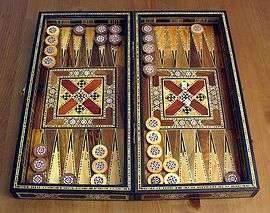Acey-deucey
Acey-deucey is a variant of backgammon. Since World War I, it has been a favorite game of the United States Navy, Marine Corps, and Merchant Marine.[1] Some evidence shows that it was played in the early 1900s aboard U.S. Navy ships. The game is believed to be rooted in the Middle East, Greece, or Turkey, where there were variants in which the game started with pieces off the board.[2]
.jpg)
Compared to standard backgammon, acey-deucey is more like a race than a strategy game.[3] It features a differing starting position, opening play, and rules for the endgame. Because pieces may be retained in one's opponent's home board, the game offers substantial opportunities for backgame play.
Other meaning
Acey-deucey is deliberately riding a horse with one stirrup shorter than the other. It is most often seen in racing in the United States, where a jockey will slightly lengthen the inside stirrup to gain better balance on turns, all of which are left-handed in America. Some riders believe this helps them.[4]
Initial setup

The components of acey-deucey match those of backgammon, including identical boards, number of pieces, and dice. Unlike standard backgammon, all of both players' pieces are off the board when the game begins.[5] Acey-deucey does not use the doubling cube.[1]
Opening play
The initial play is markedly different from that of standard backgammon. Pieces are entered onto the opponent's inner board as if they were on the bar. Once a piece has been entered, it can be moved even though other pieces have not been entered.[3] One strategy in the game is to keep one man, called an "Oscar", off the board until it is needed for defensive purposes.[6]
Play
Play passes back and forth, with each player rolling both dice.
A player who rolls doubles may move a total of four times, each move traversing as many spaces as the rolled amount (two fives rolled result in four moves of five points each). After rolling these doubles, the player takes another turn.
If a player rolls an acey-deucey (= a 1 and a 2), he plays the 1-and-2; then they choose any number from 1 to 6 and act as if they had just thrown a double of it; then that player takes another turn.
After the opening, gameplay is nearly identical to that of backgammon, with some notable differences:
- After rolling and playing doubles or acey-deucey, the player must roll and move again.
- A roll of acey-deucey counts as a 1-2, and as doubles of the player's choice.
- Upon reaching one's own home board, a piece may not be moved again until all others have arrived.
- An exact roll is required to bear off.
- A player can move pieces even if he has pieces on the bar.
Terminology

The terminology of acey-deucey is somewhat different from that of backgammon. The initial rolling of one die is called the peewee or piddle. The bar is the fence, and a single man is kicked rather than hit. The opponent's inner table is called the entering table or starting quarter, and one's own inner table is the finishing quarter.[5]
Variants
Variants of the above rules exist that make the game more restrictive.
- Upon rolling acey-deucey, the player does not choose the doubles for their next move. Instead, they roll one die and use that number for the doubles choice.
- If a player rolls acey-deucey but is unable to utilize both the 1 and 2 (most likely because he is blocked), their turn ends. They do not get any doubles, and they do not get another roll.
- If a player rolls doubles but is unable to utilize all 4 moves (most likely because they are blocked), their turn ends. They do not get another roll. This rule also holds for doubles following an acey-deucey.
- Pieces may be freely moved inside one's home (bear-off) area until all other pieces have arrived. This is the opposite from the description above.
- Once all pieces have arrived to the player's home area, they may not move any more.
- Unlike regular backgammon, players may only bear off pieces that exactly match the dice roll. For instance, if the 6 and 5 points are open and the player rolls a 6-5, they may not use that roll to bear off a checker from the 4-point.
- Pieces may be only moved from the bar upon rolling doubles.
- The ability to take extra rolls for doubles and acey-deucey during bearing off have the same rules stated above. If a player rolls an acey-deucey but cannot bear off a checker from both the 1-point and the 2-point, they are not entitled to a roll for doubles or another turn.
- If a player rolls a 6-6 and only has three checkers on their 6-point to bear off, they may not take another turn (although they can bear off the three checkers from that point).
- At the beginning of the game, no checker may be put into play unless a double is rolled. In other words, a player may not enter a checker without first rolling a double. After the initial double, any checker may be entered as per the player's preference.
References
- "Backgammon Variants: American Acey-Deucey". Backgammon Galore!. Archived from the original on 12 January 2008. Retrieved 2008-01-22.
- "American Acey-Deucey". Play65.
- Leet, John (1998). Winning Backgammon. New York: Sterling Publishing Co., Inc. pp. 109. ISBN 0-8069-0459-3.
- http://horsehints.org/RacingTerms.htm
- Morehead, Albert H.; Richard L. Frey; Geoffrey Mott-Smith (1991). The New Complete Hoyle Revised. New York: Doubleday. pp. 588–589. ISBN 0-385-24962-4.
- Dillon, Jack (1943). How to Play Acey-Deucey. Chicago: Albert Whitman & Company.
